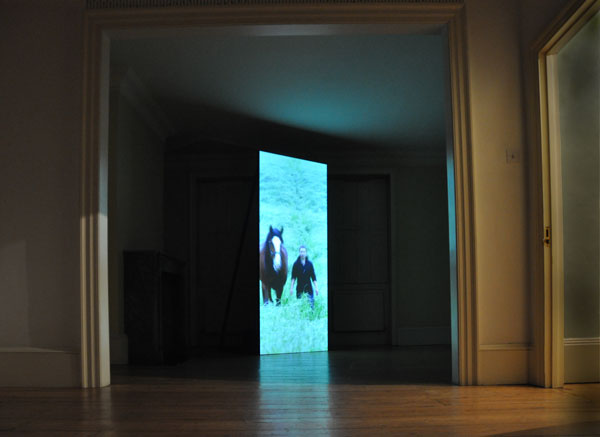| Simon Pope What Cannot Be Turned Aside |
 |
|
Simon Pope What Cannot Be Turned Aside |
|
5 - 28 October 2012 |
|
Public access to land, where it exists, has been hard-fought with ongoing skirmishes to establish rights-of-way to our woodlands, moorland and coastline. During a period as artist-in-residence at Yorkshire Sculpture Park in 2010-11, artist Simon Pope researched these issues in relation to the Bretton Park estate, walking and talking with various stakeholders along the many pathways which cross the park. His new film, What Cannot Be Turned Aside is an exploration of how we negotiate access to land and the strong impulses which are at play during this process. Within the frame we see a horse and rider negotiating their relationship with the land, walking together across an open field. Over the course of three ‘takes’ they advance towards the camera, moving within its frame, sometimes accepting its limits and at others jostling to break free from its constraints. The title of the film is drawn from David Bohm’s influential book, On Dialogue (1996) in which dialogue is seen as key to achieving harmony within a complex, unstable world. However, Bohm also recognises that the negotiation which precedes dialogue is placed at risk by our deepest prejudices and assumptions - those things that are deemed a necessity and ‘which cannot turned aside’. It is this point of conflict, between the impulses brought about from necessity and the entering into the ‘open space’ of dialogue that Pope highlights within this work. The horse and rider’s attempt to walk shoulder-to-shoulder, reminiscent of the ‘horse whispering’ techniques of Join-Up. Yet the horse’s instinct to run free constantly threatens to disrupt the hoped-for moment of mutual, harmonious walking together. This film features horses and riders drawn from the West Bretton area and is shot near the former gallops on Longside, which once also staged an annual horse fair. What Cannot Be Turned Aside is funded by Arts Council England and will also be screened at Yorkshire Sculpture Park in October 2012. To accompany the exhibition, Pope will be conducting a series of interviews to enquire into the themes and concepts which informed the work and which arise from its production. These encounters will focus on how dialogue is understood, it’s part in processes of negotiation, the ideal models which define it and its use as method in art practice and other discplines. Texts from these encounters will be published online through the Danielle Arnaud website and, at a later date, in print by Yorkshire Sculpture Park. Simon Pope’s recent work has focused on walking as a model for processes of dialogue and negotiation. Often this has involved walking and talking with others, such as in the film Memory Marathon (2010) recently screened at The Whitechapel Gallery, London and A Common Third exhibited at Danielle Arnaud in 2010. This work has also explored how objects appear within dialogue, such as in Carved From Memory (2009). These ideas form the basis of Pope’s doctoral study at the Ruskin School of Fine Art, University of Oxford, which focuses on how objects - both human and nonhuman - can be understood within dialogic art practice. Pope represented Wales at their inaugural exhibition at The Venice Biennale of Fine Art 2003 and at other venues nationally and internationally. |
| Installation views |
 |
| >home |